Assessing Student’s Perception of E-Learning
Added on 2023-06-10
38 Pages9614 Words274 Views
Running head: Assessing Student’s Perception of E-Learning 1
Assessing Student’s Perception of E-Learning
Proposal for Research Report
at the
Eastern Institute of Technology
Auckland, New Zealand
[Author’s full name]
[Year]
Statement of authenticity
By submitting this work, I declare that this work is entirely my own except those parts duly
identified and referenced in my submission. It complies with any specified word limits and
the requirements and regulations detailed in the course work instructions and any other
relevant programme module declaration. In submitting this work I acknowledge that I have
read and understood the regulations and code regarding academic misconduct, including
that relating to plagiarism, as specified in the programme handbook. I also acknowledge
that this work will be subject to a variety of checks for academic integrity.
Assessing Student’s Perception of E-Learning
Proposal for Research Report
at the
Eastern Institute of Technology
Auckland, New Zealand
[Author’s full name]
[Year]
Statement of authenticity
By submitting this work, I declare that this work is entirely my own except those parts duly
identified and referenced in my submission. It complies with any specified word limits and
the requirements and regulations detailed in the course work instructions and any other
relevant programme module declaration. In submitting this work I acknowledge that I have
read and understood the regulations and code regarding academic misconduct, including
that relating to plagiarism, as specified in the programme handbook. I also acknowledge
that this work will be subject to a variety of checks for academic integrity.
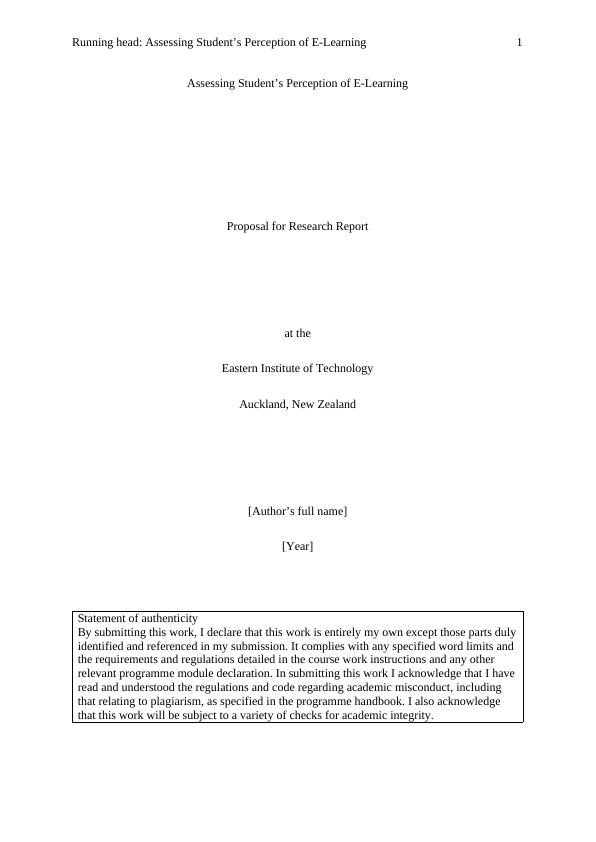
Assessing Student’s Perception of E-Learning 2
ABSTRACT
This study proposal aims at assessing the perceptions of the students towards e-learning. The
study is to be carried out because, with the increase in the use of technology, there are tools
that enhance e-learning, hence there is the necessity to ascertain the idea of the students
towards e-learning. The study will be carried out at the Eastern Institute of Technology (EIT),
New Zealand, using 50 Questionnaires with a target of 500 students across the three
campuses. The proposed outcomes of the research indicate that majority of the students have
a positive attitude towards e-learning and thus should be motivated. On the other hand, there
are challenges that impede the success of e-learning such as the attitude of the students.
ABSTRACT
This study proposal aims at assessing the perceptions of the students towards e-learning. The
study is to be carried out because, with the increase in the use of technology, there are tools
that enhance e-learning, hence there is the necessity to ascertain the idea of the students
towards e-learning. The study will be carried out at the Eastern Institute of Technology (EIT),
New Zealand, using 50 Questionnaires with a target of 500 students across the three
campuses. The proposed outcomes of the research indicate that majority of the students have
a positive attitude towards e-learning and thus should be motivated. On the other hand, there
are challenges that impede the success of e-learning such as the attitude of the students.
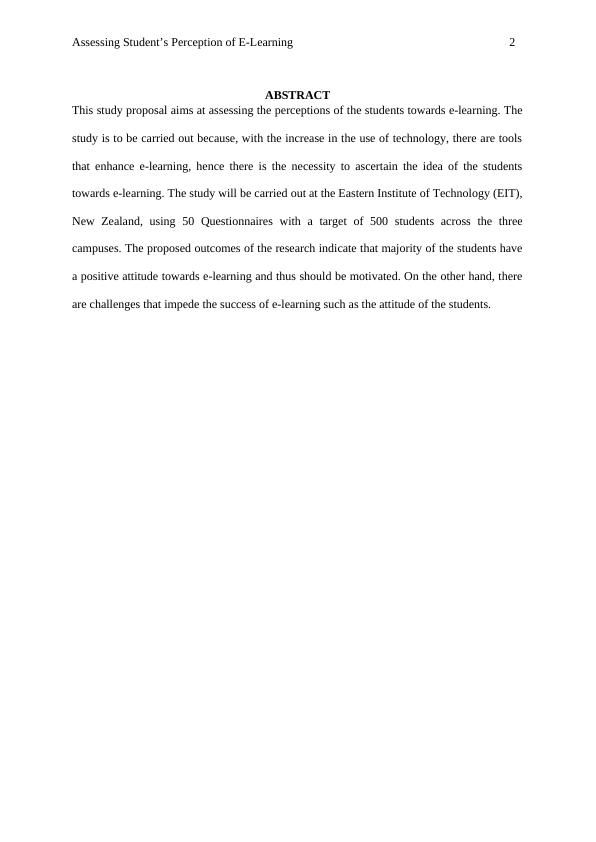
Assessing Student’s Perception of E-Learning 3
Table of Contents
ABSTRACT...............................................................................................................................2
LIST OF FIGURES....................................................................................................................5
CHAPTER ONE: INTRODUCTION........................................................................................6
1.1 Introduction......................................................................................................................6
1.2 Background.......................................................................................................................7
1.3 Problem Statement............................................................................................................8
1.3.1 Purpose of Research...................................................................................................8
1.3.2 Research Questions....................................................................................................8
1.3.3 Hypotheses.................................................................................................................8
1.3.4 Study Aim and Objectives.........................................................................................9
1.3.5 Significance of the Research......................................................................................9
1.3.6 Limitations...............................................................................................................10
1.3.7 Structure of this Report............................................................................................10
CHAPTER TWO: LITERATURE REVIEW..........................................................................11
2.1 Introduction....................................................................................................................11
2.2 Definitions of E-learning................................................................................................11
2.2 Types of E-learning........................................................................................................12
2.2.1 Fully-online learning................................................................................................12
2.2.2 Hybrid Learning.......................................................................................................12
2.2.3 Web-assisted e-learning...........................................................................................13
2.3 Awareness of E-Learning...............................................................................................14
2.4 Success factors and Challenges of E-learning................................................................14
2.5 Related Studies...............................................................................................................16
2.3 Theoretical Framework..................................................................................................18
CHAPTER THREE: RESEARCH METHODOLOGY...........................................................21
3.1 Introduction....................................................................................................................21
Table of Contents
ABSTRACT...............................................................................................................................2
LIST OF FIGURES....................................................................................................................5
CHAPTER ONE: INTRODUCTION........................................................................................6
1.1 Introduction......................................................................................................................6
1.2 Background.......................................................................................................................7
1.3 Problem Statement............................................................................................................8
1.3.1 Purpose of Research...................................................................................................8
1.3.2 Research Questions....................................................................................................8
1.3.3 Hypotheses.................................................................................................................8
1.3.4 Study Aim and Objectives.........................................................................................9
1.3.5 Significance of the Research......................................................................................9
1.3.6 Limitations...............................................................................................................10
1.3.7 Structure of this Report............................................................................................10
CHAPTER TWO: LITERATURE REVIEW..........................................................................11
2.1 Introduction....................................................................................................................11
2.2 Definitions of E-learning................................................................................................11
2.2 Types of E-learning........................................................................................................12
2.2.1 Fully-online learning................................................................................................12
2.2.2 Hybrid Learning.......................................................................................................12
2.2.3 Web-assisted e-learning...........................................................................................13
2.3 Awareness of E-Learning...............................................................................................14
2.4 Success factors and Challenges of E-learning................................................................14
2.5 Related Studies...............................................................................................................16
2.3 Theoretical Framework..................................................................................................18
CHAPTER THREE: RESEARCH METHODOLOGY...........................................................21
3.1 Introduction....................................................................................................................21
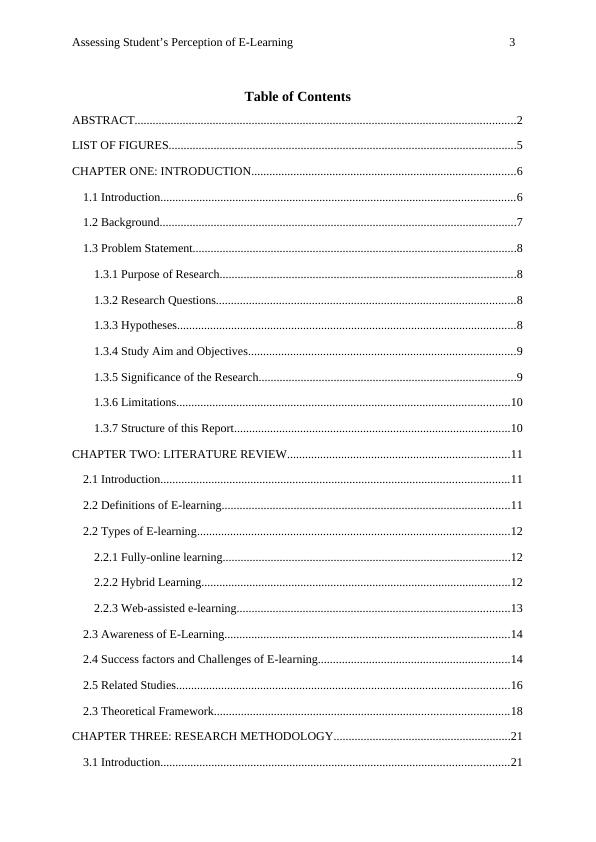
Assessing Student’s Perception of E-Learning 4
3.2 Study Design..................................................................................................................21
3.2.1 Target Population.....................................................................................................21
3.3 Research Questions and Objectives................................................................................21
3.4 Sampling and Data Collection........................................................................................22
3.4.1 Sampling Frame.......................................................................................................22
3.4.2 Sampling Technique................................................................................................22
3.4.3 Sample Size..............................................................................................................22
3.4.4 Data Collection........................................................................................................22
3.5 Data Analysis..................................................................................................................23
3.6 Reliability/ Validity/ Quality Criteria.............................................................................23
3.7 Ethical Considerations....................................................................................................23
CHAPTER FOUR: PROPOSED OUTCOMES......................................................................24
5.1 Awareness/understanding of students’ e-learning..........................................................24
5.2 Perceived usefulness/benefits of e-learning...................................................................24
5.3 Attitude of students towards e-learning..........................................................................24
CHAPTER FIVE: PROPOSED TIMELINE...........................................................................25
CHAPTER SIX: CONCLUSION............................................................................................26
REFERENCES.........................................................................................................................27
APPENDIX A: ETHICS APPLICATION...............................................................................37
APPENDIX B: QUESTIONNAIRE........................................................................................38
3.2 Study Design..................................................................................................................21
3.2.1 Target Population.....................................................................................................21
3.3 Research Questions and Objectives................................................................................21
3.4 Sampling and Data Collection........................................................................................22
3.4.1 Sampling Frame.......................................................................................................22
3.4.2 Sampling Technique................................................................................................22
3.4.3 Sample Size..............................................................................................................22
3.4.4 Data Collection........................................................................................................22
3.5 Data Analysis..................................................................................................................23
3.6 Reliability/ Validity/ Quality Criteria.............................................................................23
3.7 Ethical Considerations....................................................................................................23
CHAPTER FOUR: PROPOSED OUTCOMES......................................................................24
5.1 Awareness/understanding of students’ e-learning..........................................................24
5.2 Perceived usefulness/benefits of e-learning...................................................................24
5.3 Attitude of students towards e-learning..........................................................................24
CHAPTER FIVE: PROPOSED TIMELINE...........................................................................25
CHAPTER SIX: CONCLUSION............................................................................................26
REFERENCES.........................................................................................................................27
APPENDIX A: ETHICS APPLICATION...............................................................................37
APPENDIX B: QUESTIONNAIRE........................................................................................38
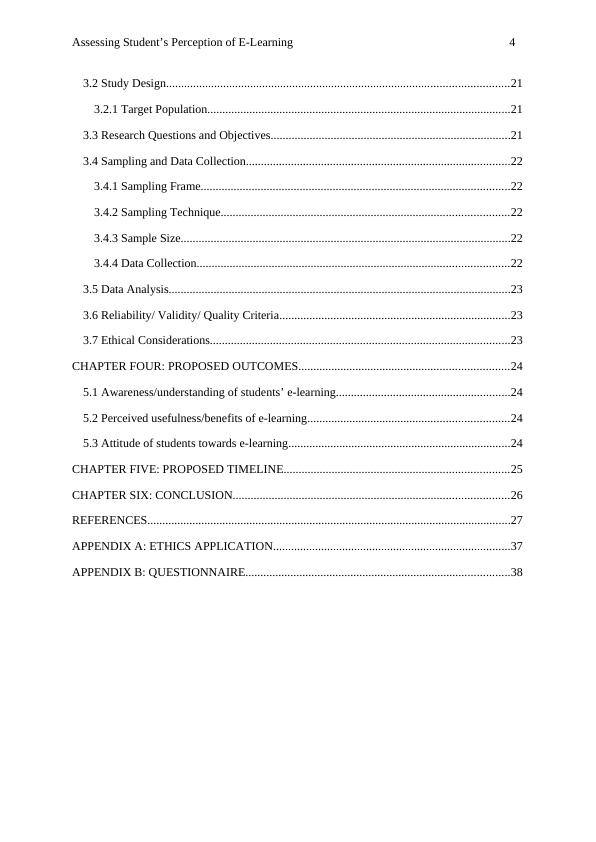
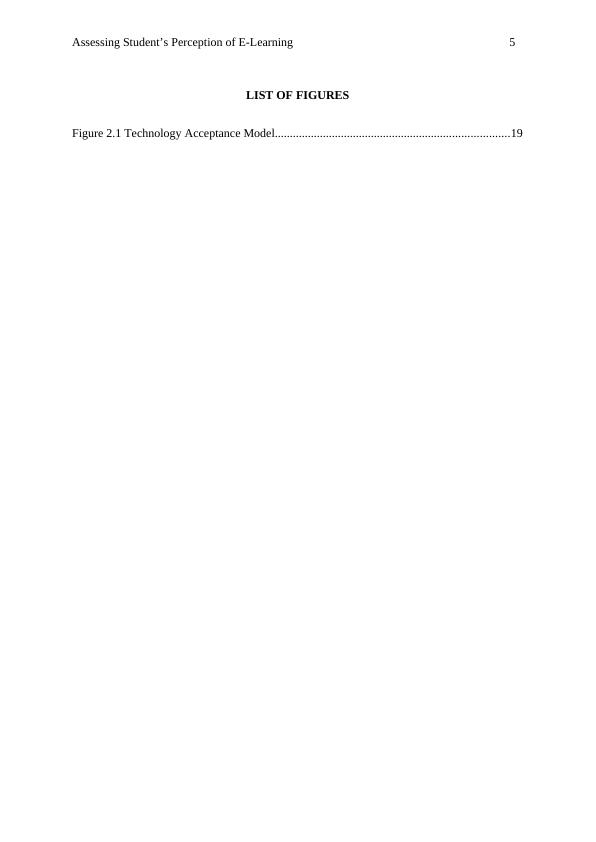
Assessing Student’s Perception of E-Learning 6
CHAPTER ONE: INTRODUCTION
1.1 Introduction
The perception of students towards e-learning in advance education can be determined by a
number of factors such as age, sex, former practise in computers, reception of technology and
personal styles of learning (Park, 2009; Rossing et al., 2012). Several studies have been
carried out on e-learning, but still not much is known with regard to the perception of the
students’ online learning (Sun et al., 2008), as a result there is required further research so as
to acquire more understanding on this subject. Other additional authors like (Keramati,
Afshari-Mofrad & Kamrani, 2011; Bertea 2009; Garrison, 2011; Park, 2009; Liaw & Haung
2011; Gormley et al., 2009; Zaharias & Poylymenakou, 2009; Moore, Dickson-Deane, &
Galyen, 2011; Ssemugabi & de Villiers 2010) have carried out studies on e-learning with
regard to the perception of students in different disciplines, however, none of them have
considered the students’ perceptions of e-learning in the faculty of both Education and
Commerce.
Ncube, Dube, & Ngulube (2014) argues that modern technological developments have
forcefully influenced institutions of higher education to adopt e-learning worldwide. Kulier et
al. (2008) and Kukulska-Hulme et al. (2011) observe that learning in higher education has
universally and frequently implemented the use of e-learning in higher education. Conole, &
Alevizou (2010); Ghirardin (2011); Park (2009) argue that worldwide use of e-learning has
been fuelled by the progressing learning environment and the increase in the demand for
education not offered on the university campus.
E-learning is a type of educational training that can be conveyed by the use of a CD-ROM
over the LAN (Local Area Network), or on the Internet, in addition to Electronic
Performance Support Systems (EPSS) and as distance learning. The benefits of e-learning
cannot be underestimated: it enables the students to study at their own speed, it makes it
CHAPTER ONE: INTRODUCTION
1.1 Introduction
The perception of students towards e-learning in advance education can be determined by a
number of factors such as age, sex, former practise in computers, reception of technology and
personal styles of learning (Park, 2009; Rossing et al., 2012). Several studies have been
carried out on e-learning, but still not much is known with regard to the perception of the
students’ online learning (Sun et al., 2008), as a result there is required further research so as
to acquire more understanding on this subject. Other additional authors like (Keramati,
Afshari-Mofrad & Kamrani, 2011; Bertea 2009; Garrison, 2011; Park, 2009; Liaw & Haung
2011; Gormley et al., 2009; Zaharias & Poylymenakou, 2009; Moore, Dickson-Deane, &
Galyen, 2011; Ssemugabi & de Villiers 2010) have carried out studies on e-learning with
regard to the perception of students in different disciplines, however, none of them have
considered the students’ perceptions of e-learning in the faculty of both Education and
Commerce.
Ncube, Dube, & Ngulube (2014) argues that modern technological developments have
forcefully influenced institutions of higher education to adopt e-learning worldwide. Kulier et
al. (2008) and Kukulska-Hulme et al. (2011) observe that learning in higher education has
universally and frequently implemented the use of e-learning in higher education. Conole, &
Alevizou (2010); Ghirardin (2011); Park (2009) argue that worldwide use of e-learning has
been fuelled by the progressing learning environment and the increase in the demand for
education not offered on the university campus.
E-learning is a type of educational training that can be conveyed by the use of a CD-ROM
over the LAN (Local Area Network), or on the Internet, in addition to Electronic
Performance Support Systems (EPSS) and as distance learning. The benefits of e-learning
cannot be underestimated: it enables the students to study at their own speed, it makes it
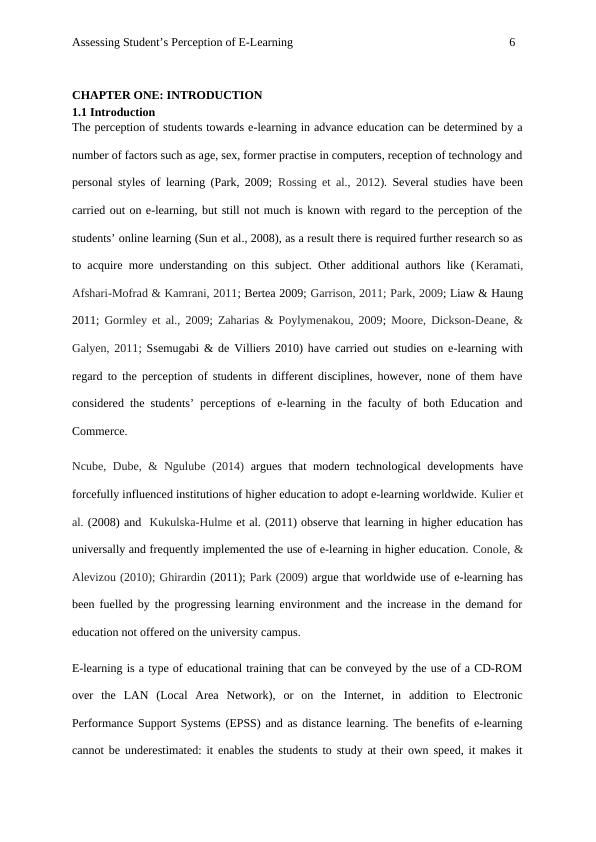
Assessing Student’s Perception of E-Learning 7
possible to customize learning to meet the varying needs of each student, and it fosters
improved communication between the students and staff among others (Greenhow, Robelia,
& Hughes, 2009).
Several studies in different contexts have been carried out on the perceptions of students of e-
learning. Tagoe (2012) carried out a study and assessed the perception of students on the use
of WebCT and ascertained that the learners appreciated the use of a course Website, and were
of the view that the course Website inspired their learning interest, and were satisfied with the
value it offered. Contrariwise, the research by Batalla-Busquets and Pacheco-Bernal (2013)
showed that one-on-one training is still regarded as a more inspirational instructional method
in comparison to virtual training.
1.2 Background
The Eastern Institute of Technology (EIT) is a government owned tertiary education
institution aimed at linking the time, topographical, financial, social, learning and
communication expanse between learners and the institution, learners and education, students
and peers (EIT, 2018). The mission of EIT is to eliminate obstacles to access education,
maintain plasticity of providing learning, focus on individual student, assisting learners and
developing training programs that are suitable for students learning (EIT Policy, 2008). EIT
is therefore an Open Distance Learning Institution (ODL) with students coming from over
forty countries across the world making it necessary for it to have the setup, resources and
tools that will enable it to offer prompt, effective and regular training. EIT has progressively
been implementing the e-learning initiative in over 50% of its undergraduate and diploma
courses. The institution has over 10, 000 students from different parts of the country. EIT has
two major faculties namely the Faculty of Educations and the Faculty of Commerce and
technology studies. The institution has three main campuses: Hawke’s Bay, Auckland,
and Gisborne, New Zealand, all offering over 130 programmes ranging from masters,
possible to customize learning to meet the varying needs of each student, and it fosters
improved communication between the students and staff among others (Greenhow, Robelia,
& Hughes, 2009).
Several studies in different contexts have been carried out on the perceptions of students of e-
learning. Tagoe (2012) carried out a study and assessed the perception of students on the use
of WebCT and ascertained that the learners appreciated the use of a course Website, and were
of the view that the course Website inspired their learning interest, and were satisfied with the
value it offered. Contrariwise, the research by Batalla-Busquets and Pacheco-Bernal (2013)
showed that one-on-one training is still regarded as a more inspirational instructional method
in comparison to virtual training.
1.2 Background
The Eastern Institute of Technology (EIT) is a government owned tertiary education
institution aimed at linking the time, topographical, financial, social, learning and
communication expanse between learners and the institution, learners and education, students
and peers (EIT, 2018). The mission of EIT is to eliminate obstacles to access education,
maintain plasticity of providing learning, focus on individual student, assisting learners and
developing training programs that are suitable for students learning (EIT Policy, 2008). EIT
is therefore an Open Distance Learning Institution (ODL) with students coming from over
forty countries across the world making it necessary for it to have the setup, resources and
tools that will enable it to offer prompt, effective and regular training. EIT has progressively
been implementing the e-learning initiative in over 50% of its undergraduate and diploma
courses. The institution has over 10, 000 students from different parts of the country. EIT has
two major faculties namely the Faculty of Educations and the Faculty of Commerce and
technology studies. The institution has three main campuses: Hawke’s Bay, Auckland,
and Gisborne, New Zealand, all offering over 130 programmes ranging from masters,
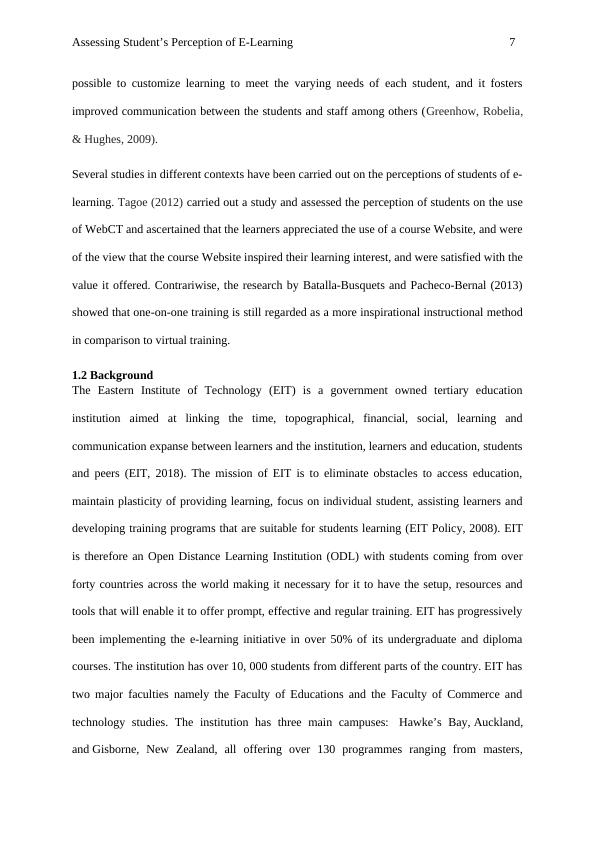
Assessing Student’s Perception of E-Learning 8
postgraduate, degree, diploma and professional certificate (EIT, 2018). With the increasing
demand for further education in the employment sector and the unavailability of time to enrol
as full time students, the programs of EIT are continuously being preferred by learners from
different categories be it employees or just new students from high school. Thus, it is critical
for EIT to ascertain the effectiveness of e-learning and the students’ perceptions as well.
1.3 Problem Statement
The studies by Kar, Saha, & Mondal (2014) and Ssemugabi and de Villiers (2010) on the
perception of the students about e-learning was on different disciplines with the exception of
both the entire faculties of commerce and technology and the faculty of educations. Buzzetto-
More (2008) conducted a study in the USA on the student perceptions of different elements
of learning and found out that course websites were the best in offering training and the
learners liked the quality of study materials. While the benefits of e-learning are
unquestionable, some other researches across the globe have hinted that tutors and learners
adopt e-learning due to a number of factors such as inadequate skills as a result of lack of
training, lack of insight, in addition to rejection (Anderson & Dron, 2011;Zaharias, &
Poylymenakou, 2009). The challenges associated with the use of e-learning affect the
perception of the students towards e-learning. Thus, this study aims at assessing the students’
perceptions about e-learning at EIT.
1.3.1 Purpose of Research
The purpose of the study will be to assess the perceptions of EIT students towards e-learning.
1.3.2 Research Questions
i. Is there any awareness/understanding among students of the e-learning platform?
ii. What are the perceived usefulness of e-learning to students’ success?
iii. What are the attitudes of students towards e-learning?
1.3.3 Hypotheses
Hypothesis 1
postgraduate, degree, diploma and professional certificate (EIT, 2018). With the increasing
demand for further education in the employment sector and the unavailability of time to enrol
as full time students, the programs of EIT are continuously being preferred by learners from
different categories be it employees or just new students from high school. Thus, it is critical
for EIT to ascertain the effectiveness of e-learning and the students’ perceptions as well.
1.3 Problem Statement
The studies by Kar, Saha, & Mondal (2014) and Ssemugabi and de Villiers (2010) on the
perception of the students about e-learning was on different disciplines with the exception of
both the entire faculties of commerce and technology and the faculty of educations. Buzzetto-
More (2008) conducted a study in the USA on the student perceptions of different elements
of learning and found out that course websites were the best in offering training and the
learners liked the quality of study materials. While the benefits of e-learning are
unquestionable, some other researches across the globe have hinted that tutors and learners
adopt e-learning due to a number of factors such as inadequate skills as a result of lack of
training, lack of insight, in addition to rejection (Anderson & Dron, 2011;Zaharias, &
Poylymenakou, 2009). The challenges associated with the use of e-learning affect the
perception of the students towards e-learning. Thus, this study aims at assessing the students’
perceptions about e-learning at EIT.
1.3.1 Purpose of Research
The purpose of the study will be to assess the perceptions of EIT students towards e-learning.
1.3.2 Research Questions
i. Is there any awareness/understanding among students of the e-learning platform?
ii. What are the perceived usefulness of e-learning to students’ success?
iii. What are the attitudes of students towards e-learning?
1.3.3 Hypotheses
Hypothesis 1
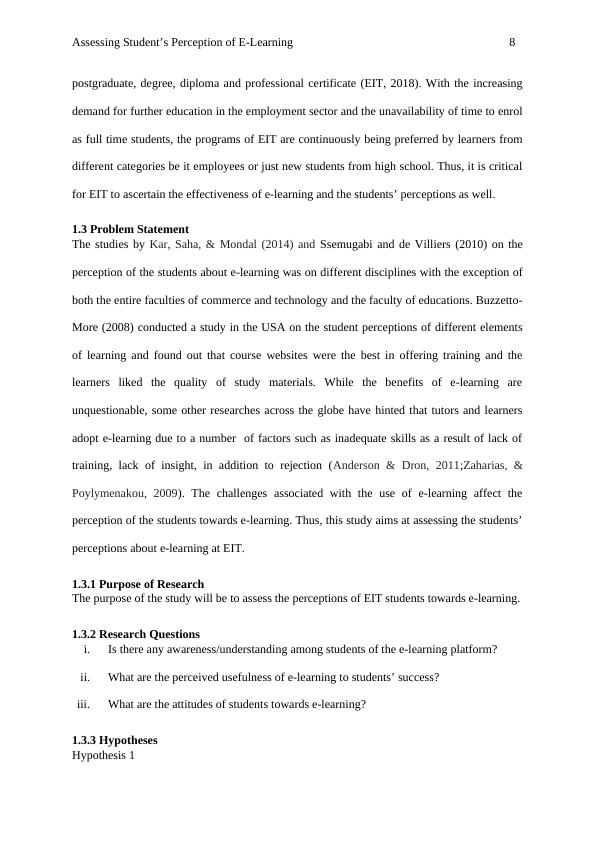
End of preview
Want to access all the pages? Upload your documents or become a member.
Related Documents
The Impact of Attitude Towards Mathematics on Students’ Academic Achievement in Mathematicslg...
|39
|9474
|217
The Effects of Performance Appraisal System on Employees’ Performance in the Public Service of Jamaica – A Case Study of the Jamaica Constabulary Forcelg...
|73
|23248
|190
The Effects of Performance Appraisal System on Employees’ Performance in the Public Service of Jamaica – A Case Study of the Jamaica Constabulary Forcelg...
|70
|22885
|249
A Study on a Major Construction Management Challenges in Delivering Quality Construction Projects of Indialg...
|73
|12951
|467
The Effect of the Perceived Ease of use, Trust and Risk on Usage Intentionslg...
|38
|6576
|61
Impact of Learning and Development Initiatives Paperlg...
|58
|13299
|323
